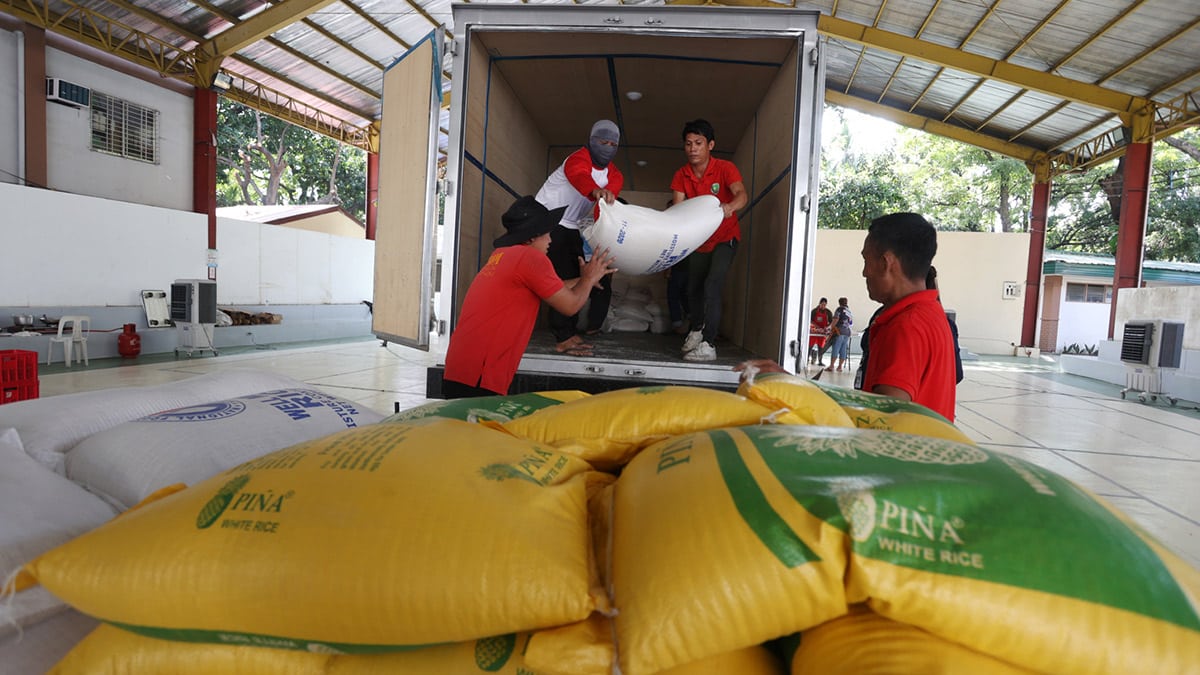DA: Kadiwa rice eyed vs high prices

KADIWA STORES Workers unload rice at a Kadiwa Store in Malate, Manila, on Thursday. —NIO JESUS ORBETA
The Department of Agriculture (DA) is targeting to roll out its Rice-for-All program in major public markets in Metro Manila and adjacent areas in a bid to cool down “persistently high” retail prices of the staple food.
In a Zoom interview on Friday, Agriculture Assistant Secretary Arnel de Mesa said the agency intends to start selling discounted rice to markets “within December.”
“We’ll start in … [the] National Capital Region, and then gradually implement the Rice-for-All program in provinces,” said de Mesa, who is also the DA’s spokesperson.
The DA said the program was in response to the discrepancy between “unusually high” retail prices and reduced import duties.
Price-cost discrepancy
“We’ve tried to avoid selling rice in major public markets to protect the livelihood of rice vendors,” Agriculture Secretary Francisco Tiu Laurel Jr. said in a statement.
Article continues after this advertisement“But since they haven’t significantly lowered prices for well-milled and regular-milled rice, we are now forced to step in and offer Kadiwa rice. This will allow us to supply consumers directly and compete with retailers,” he said.
Article continues after this advertisementREAD: DA target: More Kadiwa stores outside NCR
Tiu Laurel said the wholesale price of imported rice ranged between P37 per kilogram to P38 per kg based on actual price bulletins, as opposed to the prevailing market price of P40 per kg to P54 per kg for imported rice.
De Mesa said the DA is coordinating with farmers’ cooperatives and associations, the Food Terminal Inc. and market masters to sell cheaper rice under this initiative.
“We held consultations with all our stakeholders, particularly with enforcers, traders and retailers, and such consultations will continue to determine the best course of action to lower retail prices,” he said in Filipino.
Tiu Laurel earlier said the DA was left with no other choice but “to take a more direct approach” due to slow progress.
This, as retail prices of rice remain elevated despite reduced tariffs on the staple food and declining international prices.
Under Executive Order No. 62, which took effect in July, the import duty on rice was slashed to 15 percent from 35 percent until 2028.
The Rice-for-All program unveiled by the DA last August allows the general public to purchase rice for P42 per kg, lower than current market prices. The commodity is sourced from rice importers and local traders.
Within targets
The DA bared the program as the Monetary Board said in a separate statement on Friday that it was hoping lower rice prices would offset the rise in the cost of living.
The MB, which oversees the monetary stability and the Bangko Sentral ng Pilipinas (BSP), said upward price pressures would continue until after December, but predicted that the cost of living would remain within government targets.
“Increased prices of vegetables, fish, and meat due to unfavorable weather conditions, higher electricity rates and petroleum prices, and the depreciation of the peso are the primary sources of upward price pressures this month,” the BSP said.
But the BSP projects that inflation for November would settle within the range of 2.2 to 3 percent.
“Going forward, the Monetary Board will continue to take a measured approach in ensuring price stability conducive to balanced and sustainable growth of the economy and employment,” the BSP said.
Economic Planning Secretary Arsenio Balisacan said in a separate statement on Friday that headline inflation, or the total rise of prices in an economy, may slightly pick up but would remain within the government’s target in November.
“We don’t think that the new number will breach our target of 2 to 4 percent. It’s probably still within that range,” he said during a briefing.
“We don’t see substantial increases in prices but we are monitoring,” he said. —WITH A REPORT FROM PNA INQ